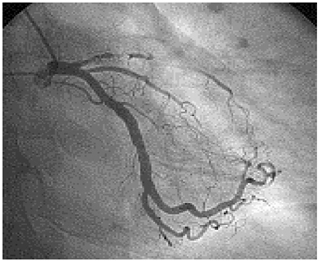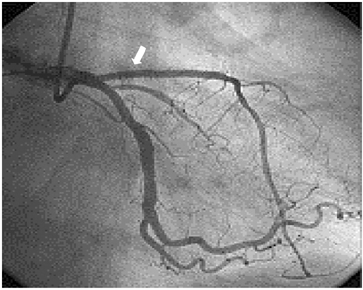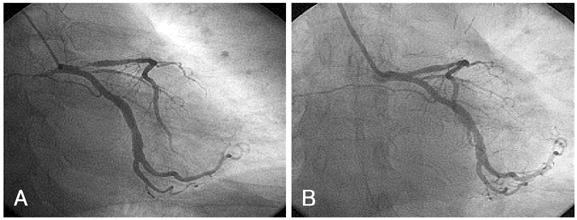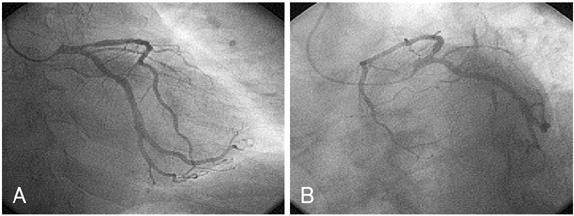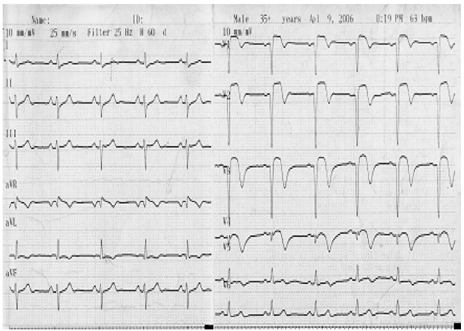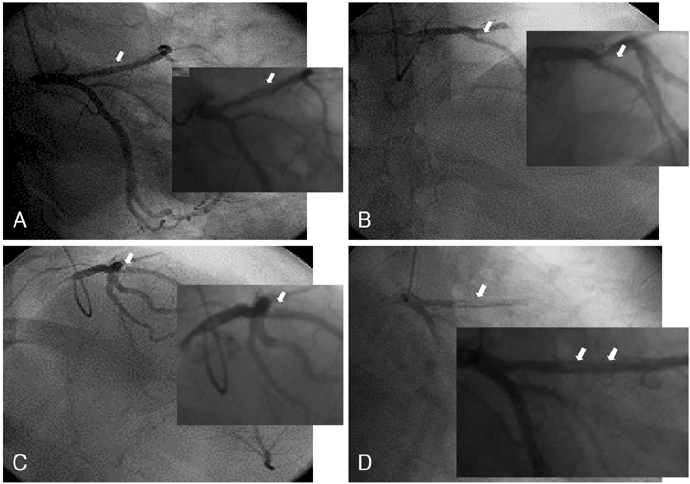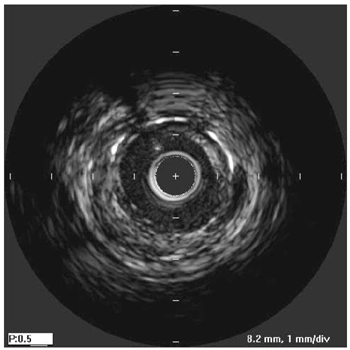Korean Circ J.
2007 May;37(5):230-233. 10.4070/kcj.2007.37.5.230.
Very Late Stent Thrombosis in Coronary Bare-Metal Stent Implantation: A Case Report
- Affiliations
-
- 1Department of Internal Medicine, Wallace Memorial Baptist Hospital, Busan, Korea. jjhoon69@yahoo.co.kr
- KMID: 2227069
- DOI: http://doi.org/10.4070/kcj.2007.37.5.230
Abstract
- Stent thrombosis is generally a fatal complication after percutaneous coronary intervention. Despite the incidence of stent thrombosis has reduced with improved techniques and drugs, stent thrombosis persists at a rate of 0.5-2% in elective cases, and up to 6% in patients with acute coronary syndromes. It almost always causes acute myocardial infarction or sudden cardiac death. While very late stent thrombosis, occurring beyond 1 year, is not uncommon with the use of drug-eluting stents, it is distinctly unusual with the use of bare-metal stents. We report a case of very late thrombosis of a bare-metal stent occurring 880 days after coronary stent implantation.
Keyword
MeSH Terms
Figure
Cited by 1 articles
-
Very Late In-Stent Restenosis in Bare Metal Stents: A Case Report
Chan Young Park, Won Yu Kang, Hyung Min Noh, Kyong Hee Hong, Myong Joo Hong, Seung Ju Kim, Sun Ho Hwang, Wan Kim
Chonnam Med J. 2010;46(3):189-191. doi: 10.4068/cmj.2010.46.3.189.
Reference
-
1. Wenaweser P, Rey C, Eberli FR, et al. Stent thrombosis following bare-metal stent implantation: success of emergency percutaneous coronary intervention and predictors of adverse outcome. Eur Heart J. 2005. 26:1180–1187.2. Apostolovic S, Perisic Z, Tomasevic M, Stankovic G, Pavlovic M, Salinger-Martinovic S. Late thrombosis of coronary bare-metal stent-case report. Srp Arh Celok Lek. 2006. 134(3-4):Abstract.3. Park DW, Park SW. Stent thrombosis in the era of the drug-eluting stent. Korean Circ J. 2005. 35:791–794.4. Manjappa N, Agarwal A, Cavusoglu E. Very late bare-metal stent thrombosis. A case report and review of the literature. J Invasive Cardiol. 2006. 18:E203–E206.5. Moussa I, Di Mario C, Reimers B, et al. Subacute stent thrombosis in the era of intravascular ultrasound-guided coronary stenting without anticoagulation: frequency, predictors and clinical outcome. J Am Coll Cardiol. 1997. 29:6–12.6. Stone GW, Ellis SG, Cannon L, et al. Comparison of a polymer-based paclitaxel-eluting stent with a bare metal stent in patients with complex coronary artery disease: a randomized controlled trial. JAMA. 2005. 294:1215–1223.7. Park SH, Hong GR, Seo HS, Tahk SJ. Stent thrombosis after successful drug-eluting stent implantation. Korean Circ J. 2005. 35:163–171.8. Katayama T, Nakashima H, Takagi C, et al. Predictors of subacute stent thrombosis in acute myocardial infarction patients following primary coronary stenting with bare-metal stent. Circ J. 2006. 70:151–155.9. Shin DH, Kwon DA, Chung JW, et al. Late stent thrombosis after intracoronary brachytherapy: learning from brachytherapy experiences in the drug-eluting stent era. Korean Circ J. 2006. 36:324–327.10. Choi BR, Lee CW, Park SW. Late stent thrombosis associated with late stent malapposition after drug-eluting stenting: a case report. Korean Circ J. 2006. 36:472–475.11. Leon MB, Teirstein PS, Moses JW, et al. Localized intracoronary gamma-radiation therapy to inhibit the recurrence of restenosis after stenting. N Engl J Med. 2001. 344:250–256.12. Parodi G, Antoniucci D. Late coronary stent thrombosis associated with exercise testing. Catheter Cardiovasc Interv. 2004. 61:515–517.13. Lee EM, Oh DJ, Kim HC, et al. Optimal balloon inflation pressures for stent deployment-high pressure is always good. Korean Circ J. 1998. 28:1272–1279.
- Full Text Links
- Actions
-
Cited
- CITED
-
- Close
- Share
- Similar articles
-
- A Case of Stent Thrombosis Occurred at 5 Years after Sirolimus-Eluting Stent Implantation
- Late Stent Thrombosis Associated with Late Stent Malapposition after Drug-Eluting Stenting: A Case Report
- Risk of Stent Stenosis after Implanting a First-Generation Drug-Eluting Stent and Drug Balloon Angioplasty
- Stent Thrombosis in the Era of the Drug-Eluting Stent
- Very Late Stent Thrombosis Related to Fracture of a Sirolimus-Eluting Stent

